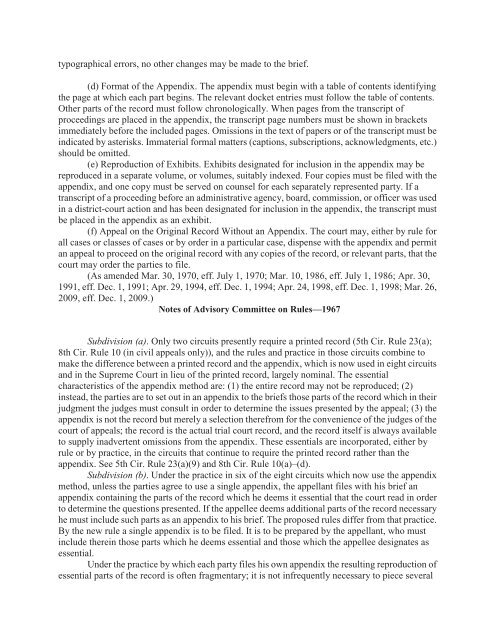Federal Rules of Appellate Procedure 2014-2015, 2014a
Federal Rules of Appellate Procedure 2014-2015, 2014a
Federal Rules of Appellate Procedure 2014-2015, 2014a
You also want an ePaper? Increase the reach of your titles
YUMPU automatically turns print PDFs into web optimized ePapers that Google loves.
typographical errors, no other changes may be made to the brief.<br />
(d) Format <strong>of</strong> the Appendix. The appendix must begin with a table <strong>of</strong> contents identifying<br />
the page at which each part begins. The relevant docket entries must follow the table <strong>of</strong> contents.<br />
Other parts <strong>of</strong> the record must follow chronologically. When pages from the transcript <strong>of</strong><br />
proceedings are placed in the appendix, the transcript page numbers must be shown in brackets<br />
immediately before the included pages. Omissions in the text <strong>of</strong> papers or <strong>of</strong> the transcript must be<br />
indicated by asterisks. Immaterial formal matters (captions, subscriptions, acknowledgments, etc.)<br />
should be omitted.<br />
(e) Reproduction <strong>of</strong> Exhibits. Exhibits designated for inclusion in the appendix may be<br />
reproduced in a separate volume, or volumes, suitably indexed. Four copies must be filed with the<br />
appendix, and one copy must be served on counsel for each separately represented party. If a<br />
transcript <strong>of</strong> a proceeding before an administrative agency, board, commission, or <strong>of</strong>ficer was used<br />
in a district-court action and has been designated for inclusion in the appendix, the transcript must<br />
be placed in the appendix as an exhibit.<br />
(f) Appeal on the Original Record Without an Appendix. The court may, either by rule for<br />
all cases or classes <strong>of</strong> cases or by order in a particular case, dispense with the appendix and permit<br />
an appeal to proceed on the original record with any copies <strong>of</strong> the record, or relevant parts, that the<br />
court may order the parties to file.<br />
(As amended Mar. 30, 1970, eff. July 1, 1970; Mar. 10, 1986, eff. July 1, 1986; Apr. 30,<br />
1991, eff. Dec. 1, 1991; Apr. 29, 1994, eff. Dec. 1, 1994; Apr. 24, 1998, eff. Dec. 1, 1998; Mar. 26,<br />
2009, eff. Dec. 1, 2009.)<br />
Notes <strong>of</strong> Advisory Committee on <strong>Rules</strong>—1967<br />
Subdivision (a). Only two circuits presently require a printed record (5th Cir. Rule 23(a);<br />
8th Cir. Rule 10 (in civil appeals only)), and the rules and practice in those circuits combine to<br />
make the difference between a printed record and the appendix, which is now used in eight circuits<br />
and in the Supreme Court in lieu <strong>of</strong> the printed record, largely nominal. The essential<br />
characteristics <strong>of</strong> the appendix method are: (1) the entire record may not be reproduced; (2)<br />
instead, the parties are to set out in an appendix to the briefs those parts <strong>of</strong> the record which in their<br />
judgment the judges must consult in order to determine the issues presented by the appeal; (3) the<br />
appendix is not the record but merely a selection therefrom for the convenience <strong>of</strong> the judges <strong>of</strong> the<br />
court <strong>of</strong> appeals; the record is the actual trial court record, and the record itself is always available<br />
to supply inadvertent omissions from the appendix. These essentials are incorporated, either by<br />
rule or by practice, in the circuits that continue to require the printed record rather than the<br />
appendix. See 5th Cir. Rule 23(a)(9) and 8th Cir. Rule 10(a)–(d).<br />
Subdivision (b). Under the practice in six <strong>of</strong> the eight circuits which now use the appendix<br />
method, unless the parties agree to use a single appendix, the appellant files with his brief an<br />
appendix containing the parts <strong>of</strong> the record which he deems it essential that the court read in order<br />
to determine the questions presented. If the appellee deems additional parts <strong>of</strong> the record necessary<br />
he must include such parts as an appendix to his brief. The proposed rules differ from that practice.<br />
By the new rule a single appendix is to be filed. It is to be prepared by the appellant, who must<br />
include therein those parts which he deems essential and those which the appellee designates as<br />
essential.<br />
Under the practice by which each party files his own appendix the resulting reproduction <strong>of</strong><br />
essential parts <strong>of</strong> the record is <strong>of</strong>ten fragmentary; it is not infrequently necessary to piece several


















